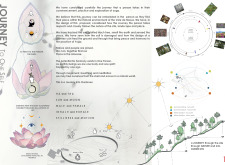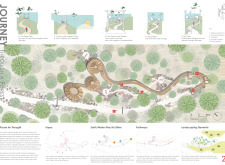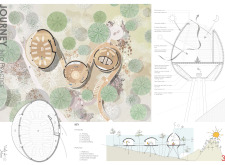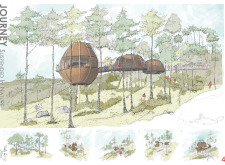5 key facts about this project
At its core, the project represents a journey—both metaphorically and physically. It is a space designed for introspection, reflection, and fostering a deeper relationship with nature. The architecture facilitates various functions, including areas for yoga practice, contemplation, and community gathering. Each component is meticulously conceived to encourage visitors to engage deeply with their environment, promoting wellness and mindfulness.
The layout of the project features a series of interconnected spaces that guide visitors along a composed path of exploration. Central to this design are several pavilions, each serving distinct roles within the experience. These domed structures, constructed primarily from timber and steel, utilize organic forms that resonate with the natural curves of the landscape. Their design prioritizes openness and connectivity, allowing natural light to flow into the interiors and providing panoramic views of the surrounding flora. The choice of materials not only enhances aesthetic appeal but also ensures structural integrity, with timber providing warmth and steel offering durability.
The entry pathway is designed to transition visitors from the external world into a more tranquil realm, marked by soft curves and natural materials. As participants navigate the pathways, they encounter garden spaces rich with local plant life, which encourages interaction with the environment. This deliberate integration of gardens fosters biodiversity and enhances the overall experience of the site, while also promoting a sense of ecological responsibility.
Unique design approaches are central to the project's identity. The architecture takes into account seasonal variations, positioning structures to maximize sunlight during winter months and offering shade in the summer. This thoughtful orientation not only enhances comfort but also exemplifies sustainability principles inherent to the design. Suspended walkways elevate the experience, allowing individuals to traverse the landscape without disturbing the forest floor and providing elevated views that foster a deeper appreciation for the surrounding beauty.
Furthermore, the project incorporates various sustainable features, such as water recovery systems and natural ventilation, reflecting a commitment to minimizing environmental impact. These innovations ensure that the architecture functions harmoniously within its ecosystem, promoting a sense of well-being among its users while respecting the natural environment.
Overall, "Journey to One Self" stands as a sophisticated exploration of architecture that prioritizes the relationship between human experiences and the natural world. It seamlessly integrates yoga's principles of mindfulness and connection with the environment, offering spaces that are both functional and reflective. The approach to materiality, sustainability, and seasonal engagement demonstrates a comprehensive understanding of how architecture can enhance well-being and facilitate personal journeys.
For those intrigued by the philosophy and design behind this project, further exploration of its architectural plans, architectural sections, architectural designs, and architectural ideas will provide a richer understanding of its conceptual framework and practical execution. Engage with the detailed presentation of the project to appreciate the full extent of its design and the unique approaches it brings to the field of architecture.


























